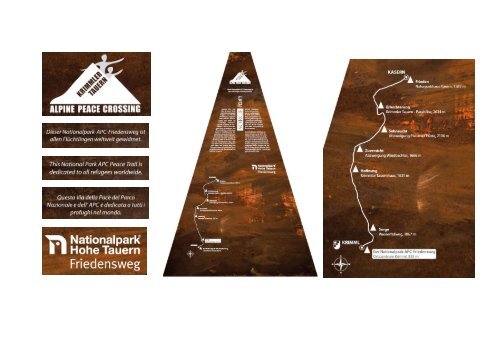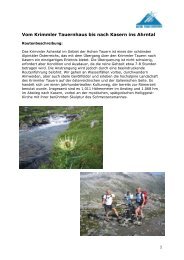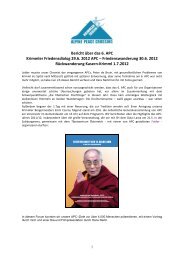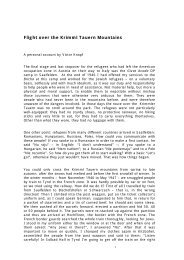Tagesordnung überproportional Gesamtbevölkerung Million Leben
Krimml, Wasserfallweg: 1067 m - Alpine Peace Crossing
Krimml, Wasserfallweg: 1067 m - Alpine Peace Crossing
- No tags were found...
Create successful ePaper yourself
Turn your PDF publications into a flip-book with our unique Google optimized e-Paper software.
200,000 Holocaust survivors were accommodated in the so-called “transit camps” in the city and province of Salzburg. One of the largest camps was “GivatAvoda” (still existing today as the Wallner Barracks) in Saalfelden, from where refugees were transported in trucks to Krimml.On the occasion of the 60 th anniversary of this exodus, the peace initiative Alpine Peace Crossing was founded in 2007 by Dr. Ernst Löschner. The firstmemorial crossing took place in the presence of ten Jewish contemporary witnesses and the, by then, 94 year old Marko Feingold, who had initiated thisfreedom route for the Jewish refugee aid organization Bricha (“Flight”).This peace trail is dedicated to all refugees in the world today.דאגה – ANXIETYKrimml, sentiero della cascata, 1067 metri di altezzaEstate del 1947, le 2 del mattino. È qui che i profughi ebrei, 5.000 uomini, donne e bambini, si riunirono in gruppi di 150-200 persone con la prospettiva di unpericoloso cammino di 15 ore. Anche dopo la fine della seconda guerra mondiale gli ebrei venivano perseguitati e la fuga illegale era il solo modo perraggiungere la loro meta, la Palestina. I paesi dell’Europa dell’Est, da cui provenivano i profughi, per loro ormai non erano che i cimiteri dei loro cari.Nell’estate del 1947 vi era una sola via di fuga: la dura traversata verso l’Italia ai 2634 metri di altezza del Passo dei Tauri, ogni altra via essendo preclusa sottola pressione politica della potenza mandataria in Palestina, la Gran Bretagna.200.000 sopravvissuti all’Olocausto furono sistemati in centri di raccolta nella città o nella provincia di Salisburgo. Uno dei centri più grandi era il „GivatAvoda“ (oggi caserma Wallner) a Saalfelden, da dove i profughi venivano portati con i camion a Krimml.Per commemorare il sessantesimo anniversario di questo esodo è stata lanciata da Ernst Löschner nel 2007 l’iniziativa „Alpine Peace Crossing“. Alla primamarcia commemorativa erano presenti dieci testimoni ebrei e il 94enne Marko Feingold, colui che nel 1947 individuò la via di fuga per l’organizzazione diaiuto ai profughi chiamata „Bricha“ (fuga).Questa via, oggi la via della pace, è dedicata a tutti i profughi nel mondo.דאגה – ANSIA
Nationalpark-APC-Friedensweg Tafel 3 von 7Krimmler Tauernhaus, 1631 mSommer 1947: Im Morgengrauen waren die jüdischen Flüchtlinge in Gruppen von 150-200 nach 5 Stunden Fußmarsch und 550 Höhenmetern am KrimmlerTauernhaus angekommen. Viele waren bereits erschöpft; eine Rast bis ca. 17 Uhr war ihnen vergönnt. Für Familien mit Kleinkindern war Liesl Geisler, dieWirtin des Krimmler Tauernhauses, die „Mutter der Flüchtlinge“. Sie kochte „Papperl“ (Mehlbrei) für die Kinder, wusch die Windeln und betreute auchaufopfernd die Erwachsenen. Aber noch hatten sie einen beschwerlichen Marsch von zehn Stunden mit mehr als 1000 Höhenmetern Aufstieg bis zurPassüberquerung im Dunkel der Nacht und danach einen steilen Abstieg vor sich … geführt wurden sie von dem mutigen Bergführer Viktor Knopf, der späterin Zell am See seine zweite Heimat finden sollte.תקווה – HOFFNUNGKrimmler Tauernhaus, 1631 m (5351 ft.)Summer 1947: At daybreak, the Jewish refugees arrived in groups of 150-200, after five hours of strenuous walking and the gain of some 550 m (approx.1800 ft.) altitude, at the Krimmler Tauernhaus. Many were already utterly exhausted; a rest until around 5 p.m. was granted. The innkeeper at the KrimmlerTauernhaus, Liesl Geisler, became, for families with young children, very much the ”Mother of the Refugees”. She cooked gruel for the children, washednappies and, in a very self-sacrificing way, catered to the needs of the adults, too. But ahead still lay an arduous ten hour trek over the pass in the darknessincluding more than 1000 m (3280 ft.) altitude difference of ascent and steep descent … they were led by a brave mountain guide, Viktor Knopf, who waslater to make his home in Zell am See.תקווה – HOPE
Rifugio Krimmler Tauern, 1631 metri di altezzaEstate del 1947: I profughi ebrei arrivarono all’alba, in gruppi di 150-200 persone, al rifugio Krimmler Tauern, dopo una marcia di 5 ore e 550 metri didislivello. In molti erano sfiniti, sicchè venne loro concessa una sosta sino alle 17. La titolare del rifugio, Liesl Geisler, era considerata dalle famiglie conbambini piccoli „la madre dei profughi“. Era lei che cucinava un impasto di farina per sfamare i bambini, che lavava loro le fasce e, con spirito di sacrificio, sioccupava anche degli adulti. Per i profughi si prospettava una marcia durissima: dieci ore, con il superamento di un passo nel cuore della notte, 1000 metri didislivello in salita e altrettanti di ripidissima discesa. Li conduceva la coraggiosa guida Viktor Knopf, che successivamente doveva trovare una seconda patria aZell am See.תקווה – SPERANZA
Biforcazione verso la valle Windbach, 1666 metri di altezzaEstate 1947. Fino a questo punto i profughi ebrei avevano camminato alla luce del giorno. Per la maggior parte di loro iniziava qui, attraverso la valleWindbach, la risalita verso il Passo dei Tauri. In casi eccezionali alcuni dei profughi dovettero percorrere un cammino ancora più lungo attraverso tutta la valle,per poi raggiungere la Valle Aurina tramite la Forcella del Picco („Birnlücke” in tedesco).La maggioranza dei profughi era malnutrita e male equipaggiata. Portavano con sé tutti i loro averi. Fino alla casetta della dogana sotto il passo i bambinipoterono essere portati dai cavalli avelignesi che erano condotti da Franz Geisler, il figlio maggiore della padrona del rifugio Krimmler Tauern. Di lì in avantivennero sistemati sulle spalle dei genitori. Era ormai buio pesto.אמונה – FIDUCIA
Nationalpark-APC-Friedensweg Tafel 5 von 7Abzweigung zur Plauener Hütte, 2106 m1947 hatte sich der politische Druck Großbritanniens auf Italien, keine jüdischen Flüchtlinge durchzulassen, derart verstärkt, dass die Flüchtlinge einige Malevon den Carabinieri zurückgewiesen wurden (in Tirol ist ein Fall vom November 1946 dokumentiert, dass 84 Flüchtlinge in Handschellen nach Österreichzurückgeschickt wurden). In diesen Fällen musste der Bergführer Viktor Knopf den noch längeren und ausgesetzten Steig über das Heilig-Geist-Jöchl wählen,das nur über die Plauener Hütte erreichbar war.Inklusive der Anreise aus dem Lager Givat Avoda in Saalfelden bedeutete dieser fünfstündige Umweg für die Flüchtlinge und ihre Kinder eine Verlängerungder Fluchtzeit auf 20 Stunden bis zum Ahrntal!געגועים – SEHNSUCHTTurnoff to the Plauen Hut, 2106 m (6909 ft.)In 1947, the political pressure from Great Britain on Italy not to allow Jewish refugees to pass through had been significantly increased, such that refugeeswere, on occasion, turned back by the Carabinieri (the Italian military police; in Tyrol there is a documented case from November 1946 of 84 refugees beingsent back to Austria in handcuffs!) As a result, mountain guide Viktor Knopf was forced to opt for the longer and more exposed climb over the “Heilig-Geist-Jöchl” (Holy Ghost Pass), which could only be approached by passing the Plauen Hut.When one includes the journey from the Givat Avoda transit camp, this additional five-hour detour meant that the journey to the Aurina valley had beenextended to around 20 hours for the refugee families.געגועים – YEARNING
Biforcazione verso il rifugio Plauen, 2106 metri di altezzaNel 1947 la pressione politica della Gran Bretagna sull’Italia era talmente aumentata che i profughi dovettero in svariate occasioni essere rimandati indietrodai carabinieri Italiani (è documentato, per esempio, che nel Novembre 1946 in Tirolo 84 profughi vennero rimandati in Austria addirittura in manette). Laguida Viktor Knopf dovette dunque scegliere per molti dei profughi una salita ancora più lunga ed esposta attraverso la Forcella di Campo („Heilig-Geist-Jöchl“in tedesco) che era raggiungibile solo dal rifugio Plauen.Questa deviazione comportava per le famiglie dei profughi cinque ore ulteriori di cammino così che dal centro Givat Avoda a Saalfelden fino alla valle Aurina sitrattava di una marcia di venti ore.געגועים – STRUGGIMENTO
Nationalpark-APC-Friedensweg Tafel 6 von 7Krimmler Tauern – Passhöhe, 2634 mSommer 1947: Für die Flüchtlinge war es inzwischen fast Mitternacht, als sie hier ankamen; würden die Carabinieri wegschauen und sie durchlassen? Es lagauch noch der steile Abstieg nach Kasern im Ahrntal vor ihnen. Das einzige Licht waren die Sterne, und auch diese waren nicht immer sichtbar.Noch gab es keine Gewissheit, ob, wann und wie sie nach Palästina gelangen würden. Aber sie hatten zumindest die Passhöhe erreicht und standen an derGrenze zu Italien, dem Land, in dem sie ein Schiff für ihre Weiterreise zu finden hofften.הקלה – ERLEICHTERUNGKrimmler Tauern Pass, 2634 m (8641 ft.)Summer 1947: By this stage it was approaching midnight and, as the refugees reached this point, they were becoming apprehensive – would the Carabinierilook the other way and allow them to pass? The steep descent to Kasern in the Aurina valley still lay before them with all its perils. Now only starlightremained and even that was intermittent.It remained for each refugee an open question as to when, how and maybe even if they might arrive in Palestine. But, after all, they had reached the highestpoint of their trek, next to the Italian border, the country from where they hoped to travel on by ship.הקלה – RELIEFPasso dei Tauri, 2634 metri di altezzaEstate 1947: quando i profughi arrivarono a questo punto del loro cammino era ormai mezzanotte. I carabinieri li avrebbero fermati o lasciati passare? Liaspettava ancora la ripida discesa verso Casere nella valle Aurina. La sola luce erano le stelle, non sempre erano visibili.
Per i profughi ancora il dubbio: sarebbero mai arrivati in Palestina? Ma almeno erano arrivati al punto più alto del loro cammino, vicini al confine con l’Italia, ilpaese dove speravano di trovare una nave per proseguire il loro viaggio verso la Palestina.הקלה – SOLLIEVO
Centro visite del parco naturale Casere, 1582 metri di altezzaEstate 1947, ore 3 del mattino: qui terminò per 5.000 profughi ebrei dell’Europa dell’Est la faticosa traversata del Passo dei Tauri (altezza: 2634 m). Esaustierano arrivati dopo 15 ore di cammino in gruppi di 150-200 uomini, donne e bambini. L’organizzazione di aiuto ai profughi, la Bricha (fuga), si incaricò diristorarli nella vicina casa dei minatori (“Knappenhaus” in tedesco) e di avviarli verso la Palestina portandoli a Genova o in altre città di mare. I deboli e gliammalati vennero inizialmente portati a Merano o a Milano.Solo poche navi di profughi riuscirono a varcare il blocco navale britannico e a raggiungere la Palestina. Quasi tutti i profughi dovettero trascorrere un annointero a Cipro in campi profughi prima di poter sbarcare nel 1948, finalmente, nel giovane stato di Israele.שלום – PACE






